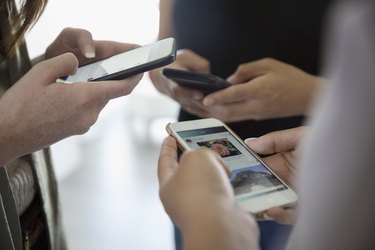
Cellphones have evolved rapidly since handheld mobile phones first appeared in the 1970s. Today, a 1990 phone or even one from later in the 1990s looks laughably primitive to people used to seeing a smart phone running iOS or Android. Generally, phones have evolved to be more compact, to have longer battery life and to allow addition of features beyond making calls, like running apps and sending text messages.
Evolution of Cellphones Timeline
Video of the Day
Motorola launched the first major handheld mobile phones in roughly 1973. Those devices weighed about 2 pounds each.
Video of the Day
Since then, cellphones have gone from being expensive devices that complement landlines for busy workers and travelers to the only phones many people use or carry. They've gone from large, clumsy devices with poor signals to reliable instruments that can easily be slipped into a pocket or purse.
The industry has also made changes to cellphone infrastructure and policies, from introducing unlimited calling plans to standardizing networks so phones can roam from one carrier's system to another, often without incurring fees or dropping calls.
Going Beyond the Call
It's easy to forget when thinking about the evolution of cellphones and the timeline in which features developed how recent some now-universal attributes of cellphones are. The short message service, used for texting, didn't appear until 1992. Downloadable ringtones, used to signal an incoming call or message, weren't available until 1998. Emojis, those representations of moods, foods and other symbols, weren't introduced until the following year.
Phones with built-in cameras, another feature that's shaped the world of photography and how we understand current events, first appeared starting in 2000. The BlackBerry, one of the first widely used devices that enabled people to send and receive email from a phone, made its debut in 1999, changing the way people stayed in touch with work colleagues outside the office.
iPhone and Android
Today, the most popular models of phones are iPhones made by Apple and various phones running Google's Android operating system from manufacturers such as Samsung, HTC and LG.
Both types of phone are considered smart phones, and they enable users to install third-party apps such as email clients, word processors, video games and dating tools. They generally include high-quality cameras that can shoot appealing pictures and videos to share on social media, as well as built-in apps for accessing the web, viewing interactive maps, sending and receiving email and, of course, handling calls and texts. Evolving cellphone networks, now often running so-called 4G and LTE technology, have ensured that they have speedy connections to the internet across the globe.
Smart phones are essentially powerful computers in their own right, and for many people they can replace other devices from stand-alone GPS units to laptops to landline telephones.
Of course, what the next iteration of cellphone looks like remains to be seen.